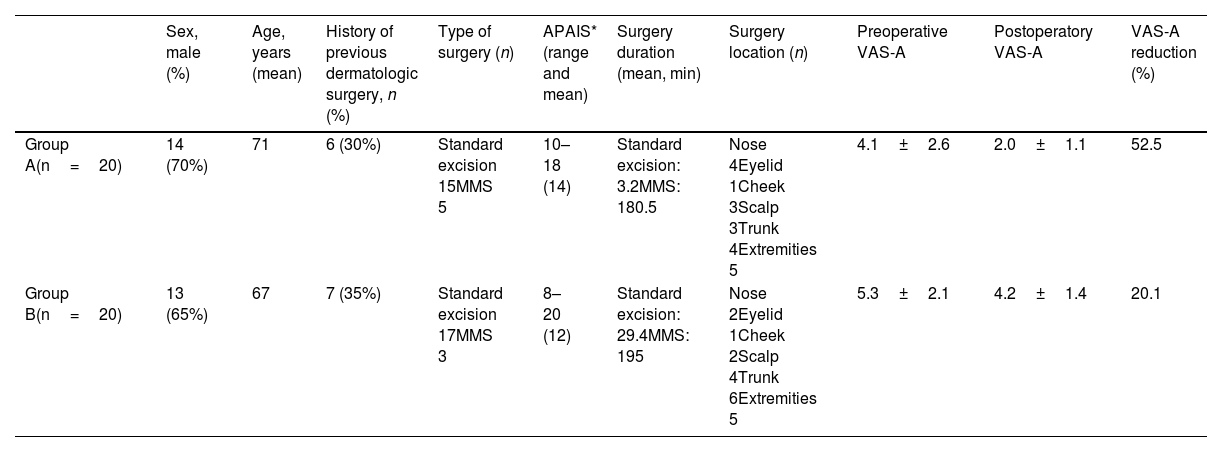We read with great interest the letter published by Sorensen et al.1 We agree that patient anxiety is lower when dermatologic surgery is performed under local anesthesia. It is our opinion, that when training, dermatologic surgeons are taught lots of technical procedures (anesthesia techniques, suture knots, an array of closures with flaps or grafts, Mohs micrographic surgery, …).2 The fact that the surgeries are usually short (with the exception of Mohs micrographic surgery) and the patients is usually awake, sometimes implies a sensation of easiness to the patient. However, in our opinion the patient feels pain or has bothersome sensations, feels the blood running when the hemostasia is not good or even hears the surgical team discuss unpleasant things about the procedure causing on the short-term different degrees of anxiety.3 Many dermatologists talk to the patients while operating, namely talkesthesia, however, the effect of this on patient anxiety has not been studied.
We aimed to describe the degree of anxiety of two different ways of doing dermatologic surgery under local anesthesia with preoperative and postoperative visual analog scale for anxiety (VAS-A). From 1st of June 2020, we randomized consecutive surgeries performed at Clinica Dermatologica Internacional (Madrid, Spain) in two groups:
- •
Group A patients were talked along during the whole procedure about general topics and classical music was playing on the background.
- •
Group B patients were operated with the same music playing but the surgical team did not initiate any kind of conversation during the procedure.
Inclusion criteria were patients that had not had previous dermatologic surgery in our center and underwent excisions with reconstructions either with flap or grafts with a minimum duration of 60min. None of the patients had anxiety problems in their past medical history nor were under anti-anxiety medication, and all procedures were conducted by the same surgical team and the dermatologist conducted the conversation with the patient. Patients were blinded. All patients gave informed consent to fulfill the surveys and the study was conducted in accordance with the declaration of Helsinki and the pertinent regional laws. The VAS-A scale was used because it has been used in similar designed articles,1 and due to its application simplicity.
Results are summarized in Table 1. Group A patients were slightly older and had a higher Amsterdam Preoperative Anxiety and Information Scale (APAIS) score. However preoperative VAS-A was higher on group B. Anxiety decrease was better on group A. Statistical analysis did not show any difference due to the sample size.
Summary of demographic data and anxiety related scores.
| Sex, male (%) | Age, years (mean) | History of previous dermatologic surgery, n (%) | Type of surgery (n) | APAIS* (range and mean) | Surgery duration (mean, min) | Surgery location (n) | Preoperative VAS-A | Postoperatory VAS-A | VAS-A reduction (%) | |
|---|---|---|---|---|---|---|---|---|---|---|
| Group A(n=20) | 14 (70%) | 71 | 6 (30%) | Standard excision 15MMS 5 | 10–18 (14) | Standard excision: 3.2MMS: 180.5 | Nose 4Eyelid 1Cheek 3Scalp 3Trunk 4Extremities 5 | 4.1±2.6 | 2.0±1.1 | 52.5 |
| Group B(n=20) | 13 (65%) | 67 | 7 (35%) | Standard excision 17MMS 3 | 8–20 (12) | Standard excision: 29.4MMS: 195 | Nose 2Eyelid 1Cheek 2Scalp 4Trunk 6Extremities 5 | 5.3±2.1 | 4.2±1.4 | 20.1 |
APAIS: Amsterdam Preoperative Anxiety and Information Scale: MMS: Mohs micrographic surgery.
The scale comprises six questions: 1: I am worried about the anesthetic, 2: The anesthetic is on my mind continually, 3: I would like to know as much as possible about the anesthetic, 4: I am worried about the procedure, 5: The procedure is on my mind continually and 6: I would like to know as much as possible about the procedure. APAIS scores from 6 to 30.
Preoperatory anxiety seems to be very variable among dermatology patients and VAS-A has been proved to show accurately the degree of anxiety in this group of patients.4,5 Music has demonstrated in many studies that helps controlling patient's unpleasant sensations and anxiety throughout all the procedure, from the waiting area to the postoperative care.1,5 In our study, we go one step forward and hypothesize that talking to our patients can enhance the tranquilizing effect of music creating a relaxed atmosphere. A limitation of our study is the lack of control group of only conversation and no music, in order to establish the real effect of “talkesthesia”.
We think this small and low-cost intervention helps increasing the patient satisfaction with the surgical team. In this modern era where artificial intelligence and teledermatology are taking over, showing closeness to our patients remains an important value. Training new generations of dermatologist should include the art of conversation.
Conflict of interestThe authors declare that they have no conflict of interest.
Thanks to our patients for being so willing and helpful. We are thankful to our head nurse, Mercedes Páez, for her help in with our patients. Thanks to Manuel G the English medical correction.





